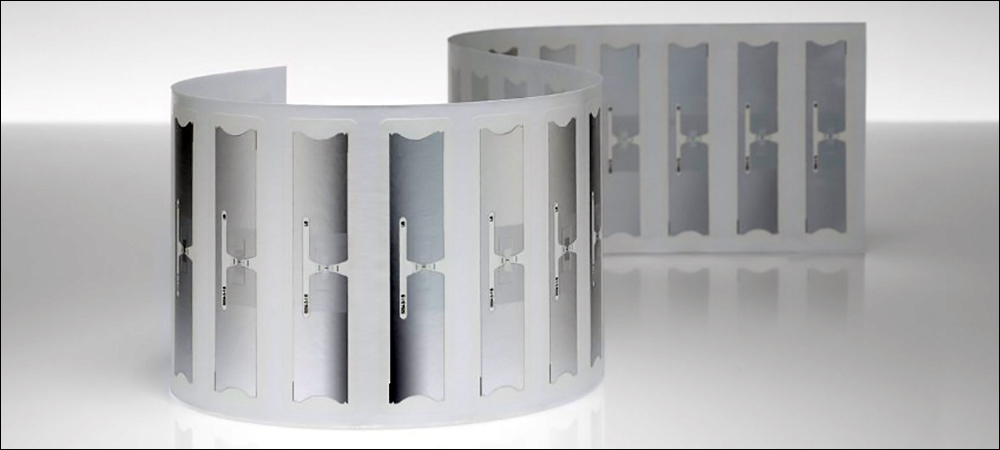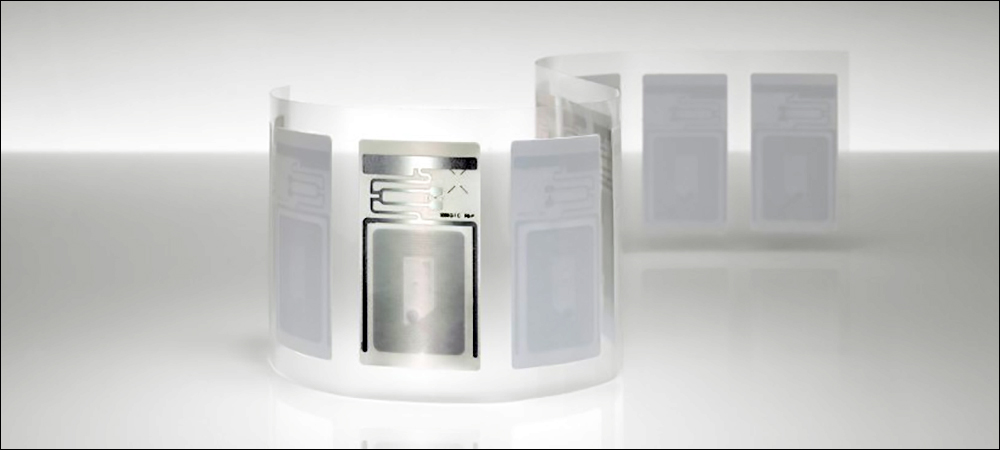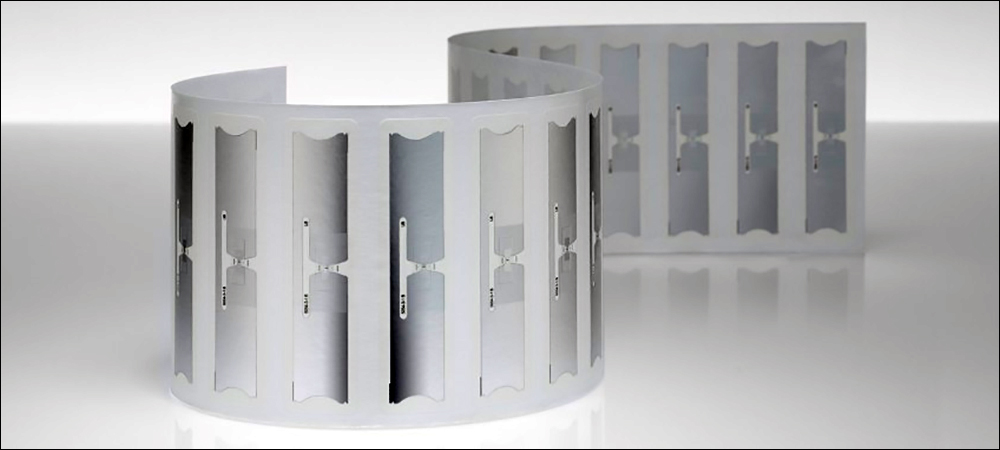Considering how COVID-19 has disrupted retail and other markets, Avery Dennison sees both challenges and opportunities ahead. For RFID, says Jeremy Schenof, Avery Dennison Intelligent Labels’ VP of strategy and new business development, opportunity can be found by providing greater visibility into inventory and supply chains, as well as offering touchless shopping to consumers at stores.
The company intends to be part of the solution, Schenof says, while also offering two new RFID tags that help serve that effort: one aimed at providing electronic article surveillance (EAS) functionality at stores, and another at offering greater sensitivity for inventory visibility in dense environments. Schenof spoke about the COVID-19 era challenges and opportunities at the recent RFID Journal Virtually LIVE! conference and exhibition, then followed up on his thoughts in an interview with RFID Journal.

Avery Dennison’s AD-332u8 tag
“COVID-19 has obviously upended our medical systems, our economies and our lives, which has led to both impacts and opportunities,” Schenof says. “Digital transformation” was a buzz word before the pandemic, he notes, though it has been accelerated this year. “In 2021, we will arrive where we thought we would be in 2026,” in terms of digital penetration in retail. That is due to consumer demands for a new retail model that includes delivery to a buyer’s door, curbside pickup options, and a more visible supply chain to help consumers understand where goods came from.
As a result of these trends, Schenof says, RFID and other Internet of Things (IoT) technologies have become a front-and-center effort for brands and retailers. For companies adjusting to a new normal in terms of product sales and delivery, he explains, COVID-19 is shining a light on shortcomings in supply chains, which means there is progress to be made for greater visibility. As e-commerce is being accelerated, the need for supply chain agility and speed requires businesses to understand the flow of products, from raw materials and manufacturing to distribution and retail sales.
In March of this year, Avery Dennison—which makes adhesive materials, packaging materials and labels—completed its acquisition of global RFID technology company Smartrac‘s RFID label business, expanding its own solutions and product offerings in the RFID market (see Avery Dennison to Buy Smartrac’s Transponder Business). The global materials science company continues to develop and provide RFID and digital ID solutions to serve apparel, automotive, industrial, logistics, pharmaceuticals, retail and other markets. This summer, the firm has released several new RFID tags designed to aid retailers in meeting shopper expectations for safety, as well as e-commerce product availability.

Avery Dennison’s AD-362r6-P inlay
The company launched its AD-332u8 RAIN RFID tag, designed to provide high bulk-reading performance for folded garments stacked on pallets or store shelves, or kept in storage. Tagged goods, such as jeans or T-shirts stacked in this manner, have historically been challenging to read, and the new inlays, using NXP‘s UCODE 8 chips, are intended to operate well in such dense environments, ensuring the accurate reading of tagged goods moving through dock doors, or stacked on shelves, being counted with a handheld reader.
The AD-332u8 meets the Auburn Laboratory ARC Program‘s Category H requirements for demanding retail environments, Schenof reports. He calls it the first Spec H inlay on the market to prove its performance and reliability within high-volume customer projects. The high-density tag can enable the further use of RFID upstream in manufacturing, or in the supply of materials to manufacturers. The goal, Schenof says, is to help companies utilize the technology “to extract more value from the fact that they’re already tagging [goods].”
The company also recently released its dual-technology AD-362r6-P inlay, which includes a UHF RFID inlay based on Impinj‘s R6-P chip combined with an EAS component. Traditionally, RFID and EAS have been deployed as separate technologies with two objectives: RFID for uniquely identifying products and inventory management and EAS for shrink prevention. EAS works well at detecting theft attempts near store exits where RFID signals might be blocked or encounter other forms of interference, Schenof explins. RFID uniquely identifies a product, while EAS does not, though RFID has faced read-effectiveness challenges at store fronts, where many tags might dwell near a door reader.
The AD-362r6-P tag serves to merge these two technologies, Schenof says, adding, “This is part of a move toward a more frictionless shopping experience.” The disposable RFID tag provides the EAS alarm in the event that an unpurchased item leaves the premises. At the same time, he says, the RFID component enables stores to understand which products have been purchased frequently and when to replenish them on the shelf, as well as in the stock room.

Jeremy Schenof
According to Schenof, Avery Dennison developed the dual RFID and EAS tag in response to retailer interest in better understanding not just when goods leave a store, but what those items are. “I think it will change the market,” he predicts, by helping move retailers on the path toward RFID for EAS. “Once you have item-level identifiers for loss prevention, there are things retailers can think about,” such as identifying inside shrink, as opposed to external theft. “This tag can serve as one tool that accomplishes two jobs.” Launched in September, the tag is targeted at large retailers, many of which may already be using RFID technology for inventory management.
Both new tags are commercially available now, Schenof reports, and are expected to be adopted by companies such as large retailers already deploying UHF RFID technology to monitor inventory. Because RFID adoption has become common in the past few years, he says, the tags may be used mostly by businesses familiar with RFID, though there is no reason why a firm new to the technology couldn’t start using the new tags for both shrink prevention and inventory management.
Avery Dennison is focused on bringing more RFID technology users into the ecosystem, Schenof says, as well as on driving adoption for new use cases. “One of the things we’re trying to do is broaden the aperture around how the technology can be used,” he states. For instance, the company’s WaveSafe tag enables the ability to manage inventory and track new categories of food, which means it could end up in a microwave oven. Recent innovations, he explains, enable beauty products to be tagged with smaller, cost-effective on-metal tags.
RFID will continue to enable transparency in supply chains, Schenof predicts, as well as in healthcare. He cites DoseID, a self-governing healthcare consortium for the management of pharmaceutical products. Avery Dennison is a member of that consortium, which is focused on enabling the RFID tracking of products destined for hospitals and patients (see Consortium Aims to Standardize RFID for Pharmaceuticals). The pandemic has also been driving new applications, such as tracking PPE and COVID-19 test kits in the supply chain.
“I think there’s a lot of room for the RFID space to grow,” Schenof says. “What’s exciting is there’s always new stones to uncover.” He cites the pharmaceutical industry, adding that “many industries have been impacted by the pandemic, shining a spotlight on inefficiencies in our supply chains that can be addressed with digital ID technologies”
Finally, Schenof reports, touchless shopping will be a demand from consumers as a result of the pandemic. Technology that enables purchases and other transactions without requiring people to touch keypads and other objects at stores will become more ubiquitous, he predicts. The company is now working to provide unmanned store solutions, along with more automated shopping experiences. “Before COVID-19, touchless was centered around payments,” he states, whereas during the pandemic, RFID technology could be employed to reduce touchpoints for the entire customer experience.


